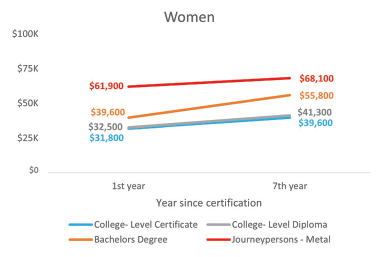
By Matthew Le Blanc
Jul 7, 2021
A recent report by the Canadian Labour Market Information Council (LMIC) and the Education Policy Research Initiative (EPRI) examined the earnings potential of men and women with trades certificates as compared to those with postsecondary degrees and diplomas.


A recent report by the Canadian Labour Market Information Council (LMIC) and the Education Policy Research Initiative (EPRI) examined the earnings potential of men and women with trades certificates as compared to those with postsecondary degrees and diplomas.
Key points from the report and Statistics Canada data include the following:
- About 4% of people working in the industrial, electrical and construction trades category in 2018 were women.
- In general, the wage gap for women in the trades is among the highest among all occupations. Women in skilled trades make on average 47% of what men earn based on earnings collected from 2009 to 2016.
- This gap is largely attributed to the fact that men tend to work in the higher paying trades, while women are over-represented in the lower paying trades.
- Women who work in the higher-paying trades fare much better, with those in the metal trades making 84% of what men earn in their 1st year of work.
- Women’s average earnings in the metal trades are highest among all post-secondary students in their first year after graduation ($61,000), making a career in the metal trades a highly desirable option.
- Welders made on average $73,000 within their first year on the job.
“This research tells us that although welding is one of the highest earning categories in the skilled trades, women who are welders still have a significant wage gap to their male counterparts,” said Susan Crowley, Executive Director of the CWB Welding Foundation. “Women in our Women of Steel network tell us that, in their experience, welding is a lucrative, rewarding and creative occupation. But we know that more needs to be done to support women in pursuing skilled trades such as welding and STEM-related professions.”
According to Statistics Canada, differences in the types of occupations men and women choose across industries explained nearly 40% of the gender gap in 2018. Men are more likely than women to work in construction, manufacturing, and mining, quarrying, and oil and gas extraction—three sectors with high wages. Women, in contrast, tend to work in fields such as teaching, social work, nursing and other health related occupations, clerical or other administrative positions, sales or services—fields with lower wages.
One of the key factors to improving the gender wage gap is getting more women involved in male-dominant fields such as the skilled trades and STEM occupations.
What is the gender wage gap?
The gender wage gap is the difference in earnings between men and women in the workplace. Although many countries have enacted various measures to combat the wage gap, differences in wages between men and women remain a reality today in Canada and globally. Leading causes of the gender pay gap include gender segregation in jobs, differences in educational attainment, caregiving responsibilities that fall heavily to women, a lack of pay transparency, discrimination, and bias. In addition, Indigenous, visible minority, disabled and newcomer women have a higher wage gap than white men working full-time.
Read the full LMIC report: https://lmic-cimt.ca/trade-earnings-report/
Sources:
- Canadian Women’s Foundation, “”The Facts about the Gender Pay Gap in Canada””: https://canadianwomen.org/the-facts/the-gender-pay-gap/
- Labour Market Information Council, “How Much Do They Make? New Evidence on the Early Career Earnings of Trade Certificate Holders”: https://www.catalyst.org/research/womens-earnings-the-pay-gap/
